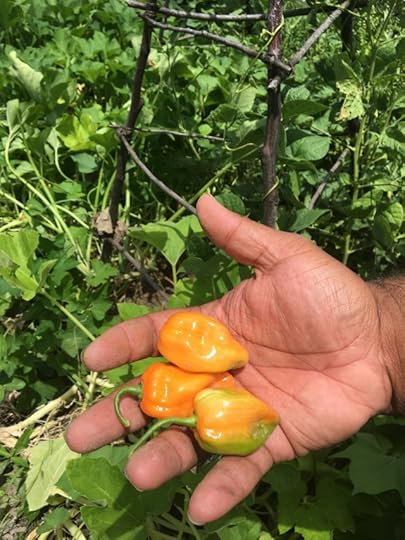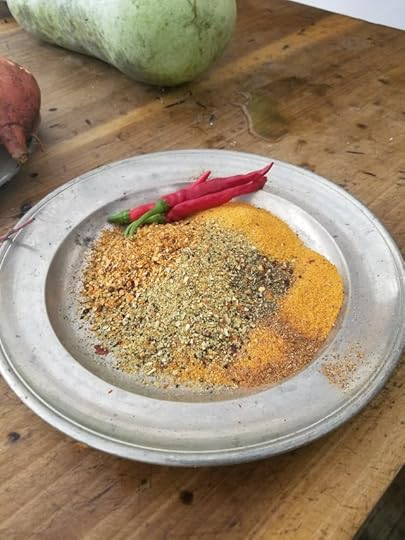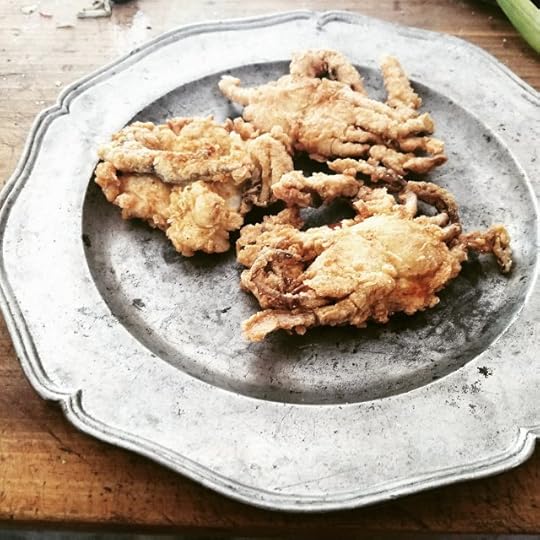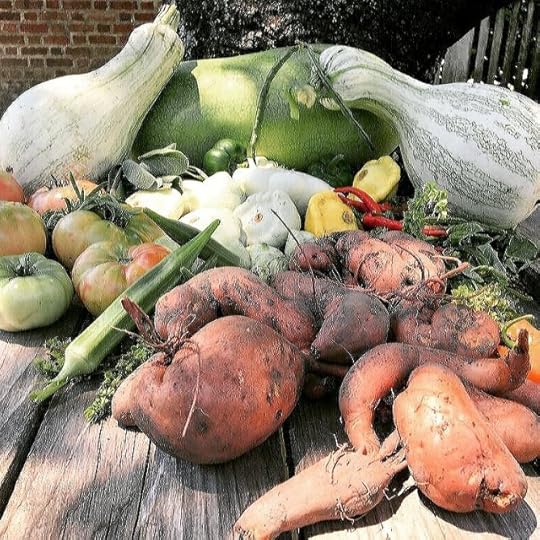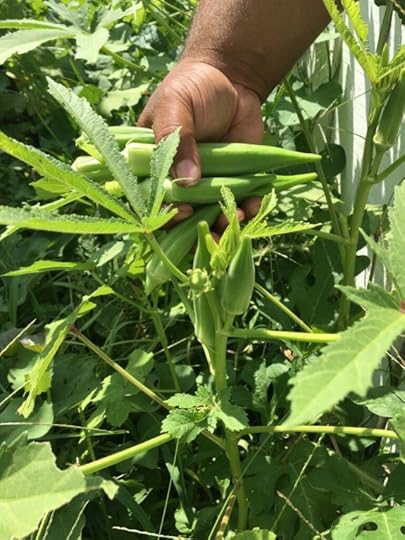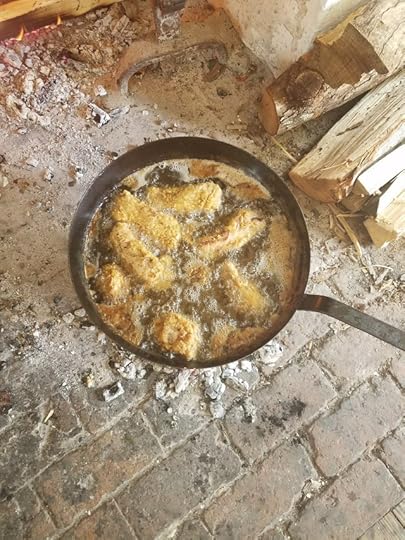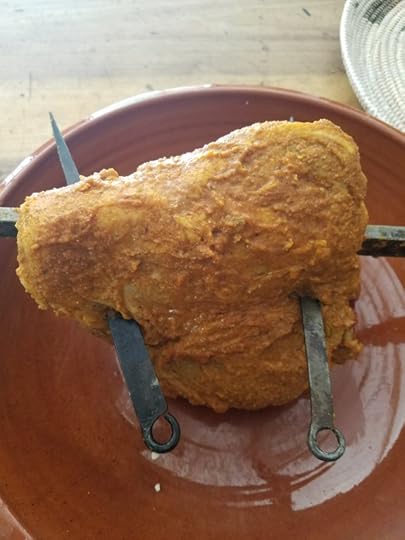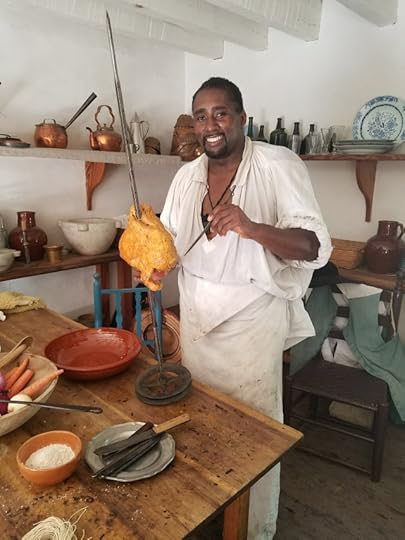Michael W. Twitty's Blog, page 6
September 19, 2017
About that hot sauce recipe…
I know what y’all want….
So this is not easy. I made a quick hot sauce on the fly from long red cayennes, habaneros, and fish peppers for the Raleigh Tavern Society at Colonial Williamsburg. It was a huge hit. I had 30 minutes to make a sauce that tasted bright, fresh, rich and felt like it had sufficiently steeped.
The peppers we used came from my African Virginian provision garden!
Things got serious:
So here….
I used a Vitamix machine on hand.
I basically pureed a yellow and a red onion, helped along by a quarter cup of Apple cider vinegar each, added about a heaping tablespoon of ginger puree. I also added a tablespoon each of kosher salt, ground cayenne pepper and red pepper flakes. I then added a teaspoon each of black pepper and kitchen pepper and a half tablespoon of hot paprika. I added half my apple cider vinegar which was about a cup. I blended this this together. I then took the washed, capped peppers (about 20 ripe, hot peppers) and blended them in the mixer with the previous mix. I added another 1/2 cup of apple cider vinegar and about 1/3 cup of dark rum and hit blend again and adjusted for taste. A little this a little that.
They added a tiny bit of xantham gum to curb separation and to each bottle I added a hot pepper cut in half.
At any rate it was a bright edition to our lovely rustic tables:
The hot sauce went well with the braised greens, chicken, rockfish and rice and pigeon peas. The menu devised between myself and Chef Justin Addison featured Chesapeake and colonial South inspired cuisine. We had cornbread kush, sweet potato biscuits with piped sorghum butter dusted with pink salt, a kale and bacon lardon salad, rockfish over roasted root vegetables, Country Captain–an early Southern curry composed of fried chicken smothered in a spicy sauce and rice and pigeon peas followed by apple dumplings, mini peach cobblers and benne *sesame wafers.
160 were in attendance. They were well satisfied.
Oh yeah and this just happened:
I am privileged and honor to join so many talented, creative people of brilliant intellect and conviction in The Root’s 2017 list of 100 most influential! Special congrats to all my sistas and brotha dem.
Oh yeah, you have your copy of The Cooking Gene yet? Order here.


About that hot sauce recipe…
I know what y’all want….
So this is not easy. I made a quick hot sauce on the fly from long red cayennes, habaneros, and fish peppers for the Raleigh Tavern Society at Colonial Williamsburg. It was a huge hit. I had 30 minutes to make a sauce that tasted bright, fresh, rich and felt like it had sufficiently steeped.
The peppers we used came from my African Virginian provision garden!
Things got serious:
So here….
I used a Vitamix machine on hand.
I basically pureed a yellow and a red onion, helped along by a quarter cup of Apple cider vinegar each, added about a heaping tablespoon of ginger puree. I also added a tablespoon each of kosher salt, ground cayenne pepper and red pepper flakes. I then added a teaspoon each of black pepper and kitchen pepper and a half tablespoon of hot paprika. I added half my apple cider vinegar which was about a cup. I blended this this together. I then took the washed, capped peppers and blended them in the mixer with the previous mix. I added another 1/2 cup of apple cider vinegar and about 1/3 cup of dark rum and hit blend again and adjusted for taste. A little this a little that.
They added a tiny bit of xantham gum to curb separation and to each bottle I added a hot pepper cut in half.
At any rate it was a bright edition to our lovely rustic tables:
The hot sauce went well with the braised greens, chicken, rockfish and rice and pigeon peas. The menu devised between myself and Chef Justin Addison featured Chesapeake and colonial South inspired cuisine. We had cornbread kush, sweet potato biscuits with piped sorghum butter dusted with pink salt, a kale and bacon lardon salad, rockfish over roasted root vegetables, Country Captain–an early Southern curry composed of fried chicken smothered in a spicy sauce and rice and pigeon peas followed by apple dumplings, mini peach cobblers and benne *sesame wafers.
160 were in attendance. They were well satisfied.
Oh yeah and this just happened:
I am privileged and honor to join so many talented, creative people of brilliant intellect and conviction in The Root’s 2017 list of 100 most influential! Special congrats to all my sistas and brotha dem.
Oh yeah, you have your copy of The Cooking Gene yet? Order here.


September 5, 2017
The Work, a Photo Essay
Those hot rolls come from a place of love.
And I can enjoy them with friends in ways the past never allowed.
Soft shelled crabs are a food I don’t indulge in but it’s a challenge to make new local foods from the Chesapeake South sing.
It’s a pleasure to be able to eat with the seasons.
And see the Red Devon cattle in the pasture and enjoy their milk.
And watch a garden come to life that represents the Ancestors.
I love learning about the intersection of nature and culture.
It thrills me to know we had a different relationship with all the species we relies upon.
This has been a good year for okra.
And beans
And melons
For sweet potato greens
And tender cymling squash
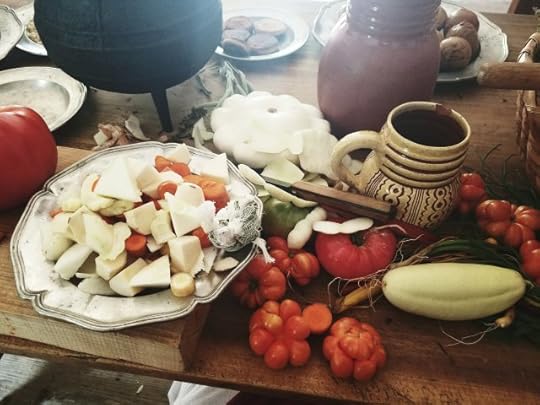 And for hot peach cobbler too..
And for hot peach cobbler too..
And for herbs and fresh tomatoes
YES we fry ribs, but its not a habit.
And we cook as a community
I learn from time alone in the woods:
And from the trees…
We cook the food of Africa too.
Seasoned well
Roasting lamb with hot peppers as they did..
Cooking our way back home…


August 31, 2017
AJC Decatur Book Festival | The Cooking Gene: A Journey Through African American Culinary History in the Old South
https://www.decaturbookfestival.com/sessions/view/594b2fde81229a5fb60ca5dd
Come see me in Atlanta this weekend at the Decatur Book Festival.


August 24, 2017
“They’re trying to take away our culture. They’re trying to take away our history,” A Wake Up Call From a Twitter Thread
Many of you asked me to put my Twitter thread into a blog post, here it goes. If you want to see where all these words really lead, and want to order my book here is a link. Thank you everyone for your support, appreciation and sense of family. No matter what your color we are family. I have edited this thread for clarity.
Get ready for a long thread. I’m feeling something I have to get off my chest. Like now.
“T
Come See Me in San Francisco 8/29-8/30
2017 Diaspora Dinner with Michael W. Twitty
When:
August 29, 2017 @ 6:30 pm – 9:00 pm
Cost:
$250
Chef-in-Residence
#moad_food
Museum of the African Diaspora and Chef-in-Residence Bryant Terry present the 2017 Diaspora Dinner
An evening with Culinary & Cultural Historian, Michael W. Twitty Celebrating his new book The Cooking Gene: A Journey Through African-American Culinary History in the Old South.
Tuesday, August 29
6:30pm The Museum Champagne & small bites 7:15pm Procession to the St. Regis 7:30pm A dining and cultural experience weaving a multi-course meal created by Chefs Twitty and Terry, inspired by African-American food traditions; lively conversation with Chef Twitty & food writer, Stephen Satterfield; and the musical collage of Jazz and Soul vocalist, Valerie Troutt.
“In addition to Twitty being a brilliant writer, he is a Black, openly gay, progressive Jew – pretty much the reason G-d created the Bay Area – the true embodiment of the diaspora.”
Chef-in-Residence Bryant Terry
$250 Includes signed copy of The Cooking Gene. Seating is limited.
Proceeds benefit the artistic programs of the Museum of the African Diaspora.
TIckets at 2017diasporadinner.eventbrite.com
For more on the Chef-in-Residence program, visit moadsf.org/chef-in-residence/
Cover photo by: Jonathan M. Lewis
[image error]
Wed. Aug. 30 • Michael W. Twitty • The Cooking Gene: A Journey Through African American Culinary History in the Old South • 6:30-7:30 p.m. FREE
Southern food is integral to the American culinary tradition, yet the question of who “owns” it is one of the most provocative touch points in our ongoing struggles over race and appropriation. In this unique memoir, culinary historian Michael W. Twitty takes readers to the white-hot center of this fight, tracing the roots of his own family and the charged politics surrounding the origins of soul food, barbecue, and all Southern cuisine.


August 19, 2017
Enjoyed the art in The Cooking Gene? Meet my illustrator, Stephen Crotts!
When you hear people talk about the enmity of white and Black Southerners you need to understand that everyday that paradigm is being challenged by the generations here and to come. When I wanted a dream team of people for this book and The Cooking Gene project I selected artists and photographers from diverse backgrounds. One friend of a friend I met in my journeys was Stephen Crotts. I wanted my book to have the rustic feel his art has. I wanted it to communicate the past translated into now. Stephen is my friend, he brought this to book to life and I want you to meet him:
How long have you been creating your art?
Everyone draws as a child, right? People find other creative outlets along the way. I just kept scribbling.
How does being from the South and especially South Carolina impact your work?
My family raised me to notice and care about the people and places surrounding me, and exposed me to Southern history, nature, food, music and more. My folks shared their faith with me, showing me what it looks like to love your neighbor. They helped me actually see the South for what it is: broken and beautiful, scarred and surviving.
When I started playing banjo in high school, I gobbled up as much as I could find about the instrument’s African origins. At college I got involved with a group of living history interpreters who were all African-American. Seeing eyes opened as we did programs about slavery in museums and on plantation sites made me want to be a bigger part of inviting people to consider the past. An artist residency in the 8th Ward of New Orleans dazzled all my senses, but not without putting my inherited advantages in contrast with the opportunities of my neighbors there. Getting to work with museums in the years since has allowed me to keep telling Southern stories in the community.
How long have you worked in this medium and what other media do you work with?
I started carrying sketchbooks in high school. Sketching from life in ink forced me to pay more attention to the marks I was making. I started and finished several of the ink drawings for The Cooking Gene in my sketchbooks. When I approach drawings loosely, on scrap paper or in my sketchbook, the work often ends up with more spontaneity and life. In addition to drawing with ink, I have also been working more in oils. Painting a landscape outdoors requires working quickly to capture whatever drama there is in front of me at that moment. The light and conditions are constantly changing, so it can be a challenge. Painting places allows me to actively observe and appreciate where I am.
[image error]
I was really impressed with how you brought the African ancestors to life. Tell me more about that process?
For some of the ancestors, we had photographs to reference. Starting there, we incorporated visual clues to their stories, such as the woven fan Elijah Mitchell holds. Additionally, we worked in botanical ornamentation of the kinds of crops the ancestors worked with. Attempting to draw people for whom we have no visual record was more of a challenge. Because of the genealogy you have done, we know which people groups these individuals belonged to. For me, it was a balance of looking at others from those groups, as well as the faces of their descendants (including yourself).
The illustrations in The Cooking Gene are really poignant because they often bring to life old photographs of my Ancestors. It’s one thing to bring out the realism, but how did you work on capturing the spirit within them?
The habit of drawing faces from life helps me get close to the edge of intangible qualities in people – those things a snapshot may not capture. I’m always hoping for more than a technically accurate rendering. I’m really looking for a sense of the person’s emotion, and I have to lean on what I’ve seen in the eyes of living people when approaching the image of someone I haven’t met.
What was your favorite illustration in The Cooking Gene?
The drawing of Jack Todd struck me. We see the mast of a ship just over his shoulder. He has just arrived in America. My imagination fails to grasp the reality of that moment, but the drawing stared me down and made me consider it. What it would mean for my family and me if I were suddenly removed from our joint pursuit of happiness? What are the consequences of refusing to recognize the image of the Creator in another human being?
You love nature and are a brilliant amateur naturalist. Your images of animals and wildlife are both fun and exact in how they evoke Southern identity. How does your relationship with nature impact your work and your relationship with the South?
Finding wild creatures is so thrilling in part because it can’t be planned, and there’s always a measure of surprise and delight in that. Daddy taught me how to whistle to the Bobwhite quail and wait for its response. My uncle took my cousin and me on weekend adventures, highlighting counties where we observed beetles, dragonflies or snakes in a binder of South Carolina maps marked for each species. Now I get to quiz my daughter on the calls of our backyard birds. Things like the appearance of wildflowers or the emerging of cicadas mark time for me throughout the year, and deeply make this place what it is.
What was challenging about working on this project? What was enjoyable?
It is challenging (and humbling) to try to honor and communicate the lives of people upon whose shoulders we are standing. The heavy lifting has been done in the writing. I hope the drawings serve as a set of eyes looking back, reminding us that what we’re reading isn’t abstract. There’s joy for me in the making of the images, but more in what they invited me to consider along the way. We have not suddenly manufactured the syncopated rhythms and rich tastes we enjoy at our cultural banquet. Every good thing is a gift that has given at great cost. Faithful stewardship begins in recognition and thankfulness.
Stephen Crotts is an artist and illustrator living with his wife and daughters in Rock Hill, South Carolina. See more of his work at scrotts.com.


August 18, 2017
The Washington Post Review of The Cooking Gene
This is cool. I pretty much like it and go, aiight.
I guess I’d like to correct a few things. 1. Because of an unscrupulous landlord and some failures on the part of the City of Rockville Code Enforcement Division to address how they broke the law, I no longer live in Rockville, Maryland. It is no longer my hometown.
Also, I didn’t drop out of Howard University, I ran out of money. Drop out and broke out are two different things. Hey, just being real.
And, “substantial girth,” yes, and? Normally I’d take that as a compliment but in this differing context….I will still take it as a compliment.
Enjoy!
Michael.


The Forgotten History of Black Chefs – Eater
https://www.eater.com/2017/8/18/16115524/michael-twitty-cooking-gene-black-culinary-history-ancestry
Honored that this selection from THE COOKING GENE appears on Eater 
August 16, 2017
Michael W. Twitty's Blog
- Michael W. Twitty's profile
- 322 followers





